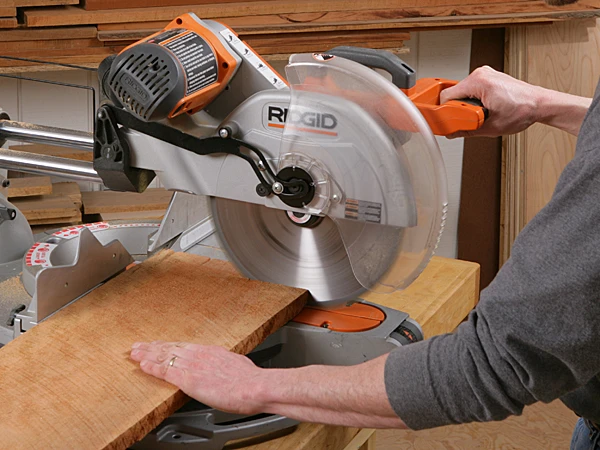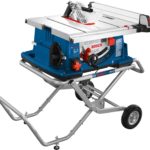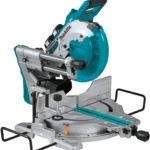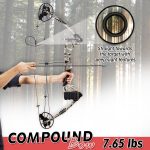A miter saw is an essential power tool widely revered for its versatility and precision. It comprises a mounted circular blade that can pivot left or right to make angled cuts, making it indispensable for tasks that demand accuracy. This tool is particularly popular among professional woodworkers and DIY enthusiasts due to its ability to execute a variety of cuts, including crosscuts, bevel cuts, and compound cuts, with remarkable exactness.
Primarily, miter saws are designed for cutting wood, offering unparalleled precision for crafting moldings, framing, and various carpentry projects. Beyond wood, many miter saws are equipped to handle materials like plastic and even some types of metals, provided the appropriate blade is used. This flexibility significantly broadens the scope of projects that can be undertaken, from simple home improvements to intricate woodworking designs.
One of the key reasons miter saws are favored in workshops and homes alike is their ability to produce clean, sharp cuts efficiently. This not only speeds up the workflow but also ensures a high-quality finish, which is critical in professional settings. The tool’s ease of use, coupled with its precision, makes it a staple in the toolkit of anyone serious about their craft.
However, the power and efficiency of a miter saw come with inherent risks. Safety is paramount when using this tool, as improper handling can lead to severe injuries. Users must always adhere to safety guidelines, such as wearing protective gear, securing the material firmly, and being mindful of where their hands are placed relative to the blade. Understanding the limitations of what materials can be safely cut with a miter saw is equally crucial to prevent accidents and extend the tool’s lifespan.
Materials to Avoid When Using a Miter Saw
When operating a miter saw, it is crucial to recognize the limitations of the tool and understand which materials are unsuitable for cutting. Certain materials pose significant risks, not only to the integrity of the saw blade but also to the safety of the user. One of the primary materials to avoid is hardened steel.
Miter saws are designed for cutting wood and, in some instances, softer metals like aluminum. Hardened steel, however, is too tough for the standard miter saw blade and can quickly dull or damage it beyond repair. Attempting to cut hardened steel can lead to severe blade wear and possible shattering, posing dangerous projectile hazards.
Glass is another material to steer clear of when using a miter saw. The saw’s rapid spinning blade can easily cause glass to shatter, leading to a multitude of sharp fragments that can result in serious injury. Moreover, the precision required to cut glass is beyond the capability of most miter saws, making it an inappropriate tool for the job. Instead, specialized glass cutting tools should be used to ensure both safety and accuracy.
Similarly, stone and concrete are not suitable for cutting with a miter saw. These materials are extremely dense and abrasive, which can quickly wear down the saw blade. The high-speed operation of the miter saw can also generate a significant amount of dust when cutting stone or concrete, creating hazardous breathing conditions and impairing visibility.
This dust can be particularly harmful if inhaled, necessitating the use of proper dust extraction and respiratory protection, which are not typically integrated into miter saw setups.
Examples of accidents resulting from improper use of a miter saw are numerous. For instance, attempting to cut a concrete block with a miter saw can cause the blade to overheat and warp, leading to uneven cuts or complete failure of the blade.
Such incidents underscore the importance of using the right tool for each material. By adhering to these guidelines and avoiding the aforementioned materials, users can maintain the longevity of their miter saws and ensure a safer working environment.
Potential Risks and Dangers
Using a miter saw to cut inappropriate materials presents several potential risks and dangers that can result in serious consequences. One of the primary hazards is the possibility of kickbacks. This occurs when the material being cut binds or pinches the blade, causing it to jerk back towards the operator.
Kickbacks can be sudden and forceful, posing a significant threat of personal injury. Therefore, understanding the types of materials that are safe to cut with a miter saw is crucial for preventing such accidents.
Another significant risk is blade damage. Miter saw blades are designed to cut specific materials, and using them on unsuitable materials can result in chipped or broken teeth. This not only reduces the efficiency and lifespan of the blade but also increases the risk of the blade shattering during operation. Blade damage can lead to costly replacements and, more importantly, create hazardous conditions for the user.
Personal injury is perhaps the most severe risk associated with improper use of a miter saw. Failing to adhere to the manufacturer’s guidelines can result in cuts, lacerations, or even more severe injuries. It is essential to recognize the limitations of the miter saw and to use it only for its intended purposes. Users should always wear appropriate protective gear, such as safety goggles, gloves, and hearing protection, to minimize the risk of injury.
Moreover, ensuring that the material is properly secured before cutting is a vital safety practice. Loose or unstable materials can shift during cutting, increasing the likelihood of kickbacks and inaccurate cuts. Using clamps or other securing devices can help keep the material steady and reduce the risk of accidents.
In summary, the potential risks and dangers associated with using a miter saw to cut inappropriate materials underscore the importance of adhering to safety guidelines. By understanding the tool’s limitations, wearing protective gear, and securing materials properly, users can significantly reduce the likelihood of accidents and ensure a safer working environment.
Alternatives and Proper Tools for Cutting Different Materials
When embarking on any cutting task, selecting the appropriate tool is pivotal for achieving optimal results. A miter saw, while versatile, is not suitable for every material. Using the correct tool not only ensures precision and efficiency but also significantly enhances safety. Here, we outline recommended tools for materials that should generally be avoided with a miter saw.
For cutting stone and concrete, an angle grinder is the preferred choice. Equipped with a diamond blade, angle grinders can effortlessly slice through tough surfaces, providing clean and accurate cuts.
Their design allows for better maneuverability and control, reducing the risk of kickbacks and ensuring smoother operations. Additionally, angle grinders come in various sizes, making them adaptable to different cutting needs and enhancing their versatility in handling various stone and concrete projects.
When it comes to glass, a specialized glass cutter is indispensable. Glass cutters are designed with a small, sharp wheel that scores the surface, allowing for precise and controlled breaks along the desired line.
This tool minimizes the risk of shattering or cracking, which is crucial for maintaining the integrity and safety of the material. The compact and straightforward design of a glass cutter also makes it easy to handle, ensuring cleaner and more accurate cuts.
For hardened steel, a metal cutting saw is the optimal tool. Metal cutting saws, often equipped with abrasive blades or carbide-tipped teeth, are specifically engineered to handle the density and toughness of steel. These saws provide greater cutting power and stability, resulting in smoother edges and reducing the risk of blade damage.
Additionally, their robust construction is designed to withstand the high friction and heat generated during metal cutting, ensuring longevity and reliability.
Choosing the right tool involves considering the material’s properties and the specific requirements of the cut. Factors such as thickness, hardness, and desired finish all play a role in determining the most suitable tool. By leveraging the correct equipment, not only is the quality of the work improved, but the safety and efficiency of the process are also significantly enhanced.



